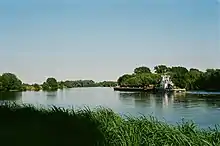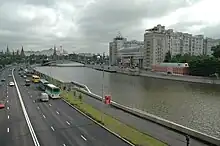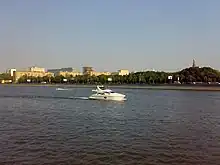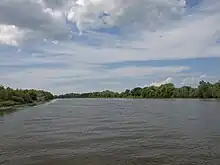Moskva (river)
The Moskva (Russian: река́ Москва́, Москва́-река́, Moskvá-reká) is a river running through western Russia. It rises about 140 km (90 mi) west of Moscow and flows roughly east through the Smolensk and Moscow Oblasts, passing through central Moscow. About 110 km (70 mi) southeast of Moscow, at the city of Kolomna, it flows into the Oka, itself a tributary of the Volga, which ultimately flows into the Caspian Sea.
| Moskva | |
|---|---|
 The Moskva at the Kremlin in Moscow | |
 Map of the Volga watershed with the Moskva highlighted; the two rivers are directly connected by the Moscow Canal | |
| Native name | Москва (Russian) |
| Location | |
| Country | Russia |
| Region | Podmoskovye |
| Physical characteristics | |
| Source | Moskva |
| • location | Sychiki, Podmoskovye |
| • coordinates | 55°30′50″N 35°21′50″E |
| • elevation | 246 m (807 ft) |
| Mouth | Oka |
• location | Kolomna, Podmoskovye |
• coordinates | 55°04′31″N 38°50′43″E |
• elevation | 98 m (322 ft) |
| Length | 473 km (294 mi) |
| Basin size | 17,600 km2 (6,800 sq mi) |
| Basin features | |
| Progression | Oka→ Volga→ Caspian Sea |
History
In addition to Finnic tribes, the Moskva River is also the origin of Slavic tribes such as the Vyatichi tribe.[1]

Etymology
Moskva and Moscow are two different renderings of the same Russian word Москва. The city is named after the river. Finnic Merya and Muroma people, who originally inhabited the area, called the river Mustajoki, in English: Black river. It has been suggested that the name of the city derives from this term,[2] although several theories exist. To distinguish the river and the city, Russians usually call the river Moskva-reka (Moskva river) instead of just Moskva.
Hydrology

The river is 473 km (294 mi) long (or 502 km (312 mi)),[3] and the area of its drainage basin is 17,600 km2 (6,800 sq mi).[4] It has a vertical drop of 155 m (509 ft) (long-term average). The maximum depth is 3 metres (9.8 ft) above Moscow city limits, and up to 6 metres (20 ft) below it.[5] Normally, it freezes in November–December and begins to thaw around late March. In Moscow, the river freezes occasionally; during an unusually warm winter in 2006–2007, ice began melting on January 25. The absolute water level in downtown Moscow is 120 metres (390 ft) above sea level (long-term average of summer lows after World War II); a historical maximum of 127.25 metres (417.5 ft) above sea level was set by the 1908 flood.[6]
Sources of water
The main tributaries of the Moskva are, from source to mouth:[4]
Sources of water are estimated as 61% thaw, 12% rain and 27% subterranean. Since completion of the Moscow Canal (1932–1937), the Moskva River has also collected a share of Upper Volga water. This has enabled reliable commercial shipping, which was previously interrupted by summer droughts (older dams built in 1785, 1836 and 1878 were not effective). The average discharge, including Volga waters, varies from 38 m3/s (1,300 cu ft/s) near Zvenigorod to 250 m3/s (8,800 cu ft/s) at the Oka inlet. The speed of the current, depending on the season, varies from 0.1 m/s (0.33 ft/s) (winter, dams closed) to 1.5–2.0 m/s (4.9–6.6 ft/s) (May, dams open).
Cities and towns

Moscow (Москва́), the capital of Russia, is situated on its banks. The river also flows through the towns of Mozhaysk, Zvenigorod, Zhukovsky, Bronnitsy, Voskresensk, and — at the confluence of the Moskva and Oka — Kolomna. As of 2007, there are 49 bridges across the Moskva River and its canals within Moscow city limits; the first stone bridge, Bolshoy Kamenny Bridge, was erected in 1692. Within the city, the river is 120–200 metres (390–660 ft) wide, the narrowest point being under the Kremlin walls. Drinking water for the city of Moscow is collected from five stations on the Moskva River and from the Upper Volga reservoirs (north and north-west of the city).
Islands
Canals, built within Moscow city limits, have created a number of islands. Some of them have names in Russian, some have none. Major, permanent islands (west to east) are:
- Serebryany Bor (park). Separated from the mainland in the 1930s.
- Tatarskaya Poyma, commonly known as Mnyovniki. Separated from the mainland in the 1930s
- Balchug Island, also known as Bolotny Ostrov, lying just opposite the Kremlin. The island was formed by the construction of the Vodootvodny Canal in the 1780s, and has no official name in Russian. Moscow residents informally call it "Bolotny Ostrov" (Bog Island) while members of Moscow's English-speaking community refer to it as Balchug.
- One uninhabited island north of Nagatino.
- Three uninhabited islands east of Nagatino, connected by the Pererva dam and lock system.
Recreation


There is a fleet of river ice-breaker cruisers which ply routes from moorings at the Hotel Ukraine and Gorky Park to the Novospassky Monastery and back. Duration of trips ranges from 1.5 to 3 hours.[7]
References
- Chubarʹi︠a︡n, A. O. (Aleksandr Oganovich) Danilevskiĭ, I. N. (Igorʹ Nikolaevich) (2009). Ot Rusi do Rossii. OLMA Media Grupp. p. 121. OCLC 891462599.
{{cite book}}: CS1 maint: multiple names: authors list (link) - Tarkiainen, Kari (2010). Ruotsin itämaa. Helsinki: Svenska litteratursällskapet i Finland. p. 19. ISBN 978-951-583-212-2.
- Москва (река), Great Soviet Encyclopedia
- «Река МОСКВА», Russian State Water Registry
- All numerical data: Russian: Энциклопедия "Москва", M, 1997 (Encyclopedia of Moscow, Moscow, 1997)
- Russian: Носарев В.А., Скрябина, Т.А., "Мосты Москвы", М, "Вече", 2004, стр.194 (Bridges of Moscow, 2004, p.194) ISBN 5-9533-0183-9
- Москвичи смогут поплавать на ледоколах. Water transport (in Russian). Moscow, Russia: [Gudok.ru]. 2009-11-13. Archived from the original on July 26, 2011. Retrieved 21 November 2009.
External links
. Encyclopedia Americana. 1920.
